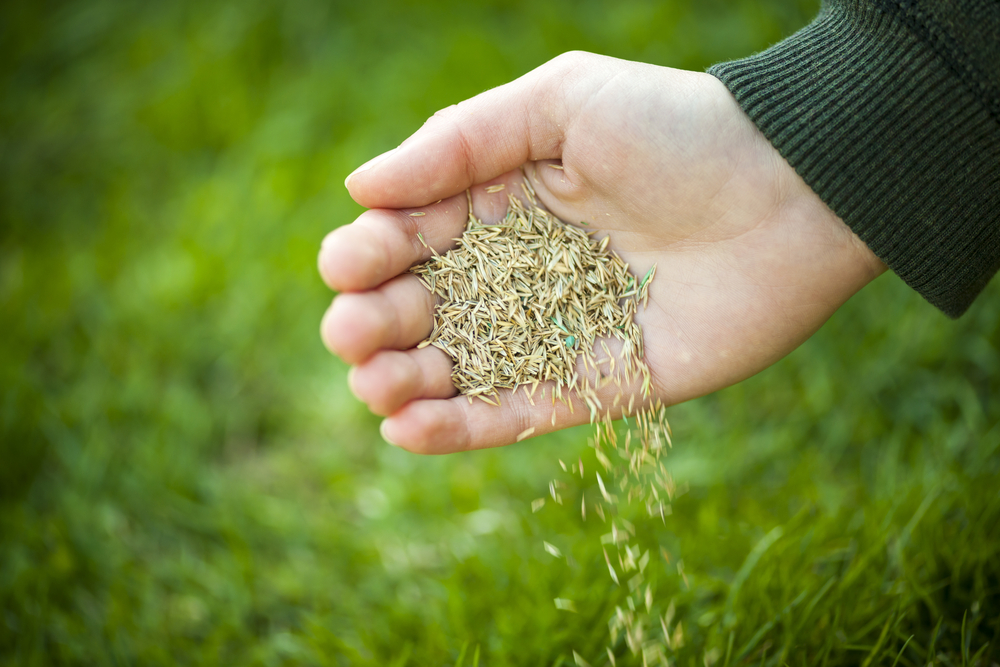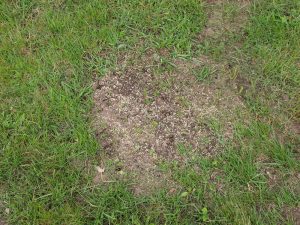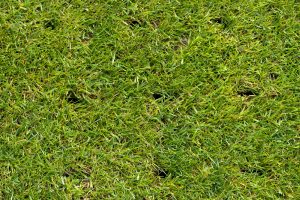
Overseeding your lawn is important to ensure a healthy, thick and weed free lawn.
Overseeding, in a nutshell, is the process of spreading grass seed over an existing lawn.
Why Overseeding Lawns is Necessary
Overseeding is important as mature plants begin to slow down their reproduction rate after several years. A blade of grass only lives an average of 45 to 60 days, so production of new tillers must continually outpace the die back of older leaves.
Sparse lawns are also more prone to take over by weeds. A thick healthy lawn leaves less room for weeds to pop up.
Signs that Your Lawn May Need Overseeding

* Your grass looks thin or you have bare patches. If you can see dirt between blades of grass, your lawn is becoming too thin.
* It has been over 4 years since you last overseeded. It is generally recommended to overseed your lawn every 3 to 4 years.
* You have brown patches.
Preparing the Grass and Soil for Overseeding
 Prior to overseeding, it is necessary to prep your lawn:
Prior to overseeding, it is necessary to prep your lawn:
- Rake grass clippings, leaves and other debris from lawn
- Mow lawn to 1”
- Do not water prior to seeding
- Power rake to dethatch lawn and remove layers of thatch in excess of 1/2”
- Core aerate for improved results
In order for grass seeds to germinate, they need to come in contact with the soil.
This is why it is important to clean up your lawn beforehand; rake grass clippings, leaves and any other material that prevent contact between the seeds and soil.
According to the Lawn Care Academy, “before overseeding is the perfect time to core aerate.” Core aeration involves pulling out plugs of grass and soil from your lawn, relieving soil compaction, increasing water availability to your roots and more.
Core Aeration is recommended once per year. Click here to learn more on the Core Aeration service we offer.
Choosing the Right Seed
Another important step in overseeding is choosing a grass seed that is compatible with your grass. Our Earth Smart Property Solutions team will help determine the best variety to use for your lawn and will use a high quality product, to help create the most favourable results.
Seeding Instructions
 If you have a small patch to overseed, then this is a task that you may want to undertake on your own. Following are some basic tips to overseed by hand:
If you have a small patch to overseed, then this is a task that you may want to undertake on your own. Following are some basic tips to overseed by hand:
- divide the amount of seed you want to spread in half.
- carefully spread half of the seed by broadcasting it over the entire area. Choose a single direction to walk while spreading the seed.
- then spread the other half of the seed at a right angle to the first direction you walked in.
By broadcasting the seed in two different directions you have a greater chance of achieving complete coverage.
If you have a large area that requires overseeding, then you may want to call a lawn care specialist. We offer overseeding in Red Deer and surrounding communities, including Olds, Ponoka, Alix, Village of Clive, Eckville, Rocky Mountain House, Bentley, Rimbey, Breton, Consort, Cremona, Raymond Shores and Bowden.
Click here to Request a Quote.
 We use an 18″ Bluebird Seeder. The rear mounted seed hopper provides the best possible seed germination because the seed is dropped after the turf is tilled by the unit’s delta blade. The seed drop agitator is a belt driven direct drive for most even seed distribution. The seed gate or seeding hole is also adjustable to accommodate a broad range of grass seed, depending on what variety of seed would work best on your turf. The seed hopper has a 30-pound capacity, perfect for covering large areas. The Seeder helps loosen the soil by creating vertical slits or grooves that help increase seed to soil contact, which is beneficial, as inn order for grass seeds to germinate, they need to come in contact with the soil.
We use an 18″ Bluebird Seeder. The rear mounted seed hopper provides the best possible seed germination because the seed is dropped after the turf is tilled by the unit’s delta blade. The seed drop agitator is a belt driven direct drive for most even seed distribution. The seed gate or seeding hole is also adjustable to accommodate a broad range of grass seed, depending on what variety of seed would work best on your turf. The seed hopper has a 30-pound capacity, perfect for covering large areas. The Seeder helps loosen the soil by creating vertical slits or grooves that help increase seed to soil contact, which is beneficial, as inn order for grass seeds to germinate, they need to come in contact with the soil.
Tips for seeding when using a machine:
For best results, seed in two passes of ½ application rate at right angles or in a criss-cross pattern
Recommended Lawn Care Maintenance after Overseeding
 Water heavily immediately after seeding, then lightly for 10-14 days keeping soil moist
Water heavily immediately after seeding, then lightly for 10-14 days keeping soil moist- After germination, water less often to promote root growth
Additional Tips
- When preparing your lawn before overseeding and cleaning up, a metal rake works best, ensuring that the tines scratch and expose the soil.
- The soil needs to be warm enough for seeds to germinate. Keep this in mind before overseeding.
- Cool season grasses are best seeded in the Fall.
- It is recommended to avoid walking on newly seeded grass until the new grass is growing
- After you overseed, don’t let the grass seed dry out. It must be kept moist until the seeds have germinated.
Please contact your local office if you have any questions.
Learn more about our Overseeding service.
Source: Lawn Care Academy, Overseeding Lawns

2 Comments